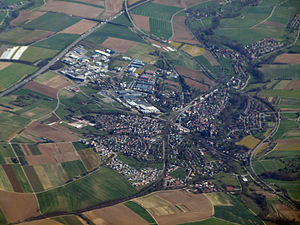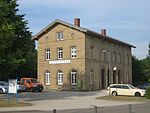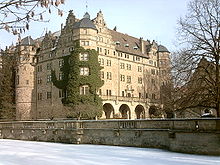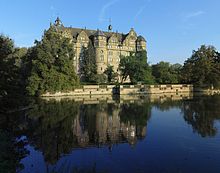Neuenstein (Hohenlohe)
| coat of arms | Germany map | |
|---|---|---|
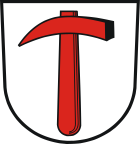
|
Coordinates: 49 ° 12 ' N , 9 ° 35' E |
|
| Basic data | ||
| State : | Baden-Württemberg | |
| Administrative region : | Stuttgart | |
| County : | Hohenlohe district | |
| Local government association: | "Hohenlohe Plain" | |
| Height : | 284 m above sea level NHN | |
| Area : | 47.84 km 2 | |
| Residents: | 6531 (Dec. 31, 2018) | |
| Population density : | 137 inhabitants per km 2 | |
| Postal code : | 74632 | |
| Area code : | 07942 | |
| License plate : | KÜN, EAR | |
| Community key : | 08 1 26 058 | |
| City structure: | 7 districts | |
City administration address : |
Schlossstrasse 20 74632 Neuenstein |
|
| Website : | ||
| Mayor : | Karl-Michael Nicklas | |
| Location of the city of Neuenstein in the Hohenlohe district | ||
Neuenstein is a town in the Hohenlohe district in the Franconian north-east of Baden-Württemberg . It belongs to the Heilbronn-Franconia region (until May 20, 2003 Franconia region ).
geography
Neuenstein has a share in the natural areas of the Swabian-Franconian Forest Mountains , Kocher-Jagst Plains and Hohenloher-Haller Plains .
Neighboring communities
Neighboring communities are Kupferzell , Waldenburg , Öhringen , Zweiflingen , Forchtenberg , Niedernhall and Künzelsau .
City structure
The city is divided into seven districts: Neuenstein, Kirchensall, Kleinhirschbach, Obersöllbach, Eschelbach, Kesselfeld and Grünbühl.
To Eschelbach the village of Eschelbach and the Eichberg homestead. To Grünbühl, the village of Grünbühl, the hamlets of Kesselhof, Lohe, Obereppach, Tannen, Untereppach, Waldsall and Wüchern and the Hohebuch residential area. To Kesselfeld the village of Kesselfeld, the hamlets of Hohrain and Pfaffenweiler and the Rebbigshof residential area (partly, also to Waldenburg). To Kirchensall the village of Kirchensall and the hamlets of Göltenhof, Langensall, Mainhardtsall and Tiergarten. To Kleinhirschbach the village of Kleinhirschbach and the hamlets Döttenweiler, Emmertshof, Großhirschbach, Deletehirschbach, Steinsfürtle and Stolzeneck. To Neuenstein, the city of Neuenstein, the hamlets of Eichhof and Klumpenhof and the Bernhardsmühle homestead. To Neureut the village of Neureut, the hamlet of Neufels and the residential area Mühle. To Obersöllbach the village of Obersöllbach.
Division of space

According to data from the State Statistical Office , as of 2014.
history
Until the 19th century
The Lords of Neuenstein , who founded their Neufels Castle and the surrounding community, were first named as contract witnesses in 1230. 1351 awarded Kraft III. of Hohenlohe-Weikersheim with the approval of King Karl IV. Neuenstein the city rights . He made the young city defensive by building city walls and moats and encouraged the local economy by setting up a weekly market. Neuenstein belonged to the Hohenlohe-Weikersheim line of Hohenlohe until 1553. When Hohenlohe split up in 1553, Neuenstein became the seat of the Hohenlohe-Neuenstein line under Count Ludwig Casimir . With the death of Count Wolfgang Julius in 1698, Hohenlohe-Neuenstein fell to Hohenlohe-Öhringen, and from then on the residence of the counts was Öhringen. Thus, Neuenstein was a royal seat from 1553 to 1698. In addition, the Hohenlohe area was part of the Franconian Empire between 1500 and 1806 . From 1698 to 1806 the city remained under the rule of the Hohenlohe-Öhringen line, which was elevated to the rank of prince in 1764.
Neuenstein came from the Principality of Hohenlohe-Öhringen to the Kingdom of Württemberg in 1806 and became the seat of its own higher office . In 1809, when the final administrative structure was implemented , Neuenstein was subordinated to the Oberamt Öhringen . In the course of the administrative reform during the Nazi era in Württemberg , Neuenstein came to the district of Öhringen in 1938 . Since the city had become part of the American zone of occupation after the Second World War , it had belonged to the newly founded state of Württemberg-Baden since 1945 , which was merged into the current state of Baden-Württemberg in 1952. In 1973 the district reform took place in Baden-Württemberg , when Neuenstein became part of the Hohenlohe district .
Community reform
- July 1, 1971: incorporation of Neureut into Kirchensall
- December 1, 1971: Incorporation of Kesselfeld into Neuenstein
- April 1, 1972: incorporation of Eschelbach and Obersöllbach into Neuenstein
- January 1, 1975: Union of Neuenstein with Grünbühl (until September 29, 1969 Obereppach), Kirchensall and Kleinhirschbach to form the new town of Neuenstein
Religions
Count Ludwig Casimir introduced the Reformation in Neuenstein around 1553 .
Catholic parish
Until 1950 the parish belonged to the Pfedelbach parish . Also due to the rapidly growing number of Catholics (1927: 51 Catholics, 1953: 962 Catholics) in the post-war period, Neuenstein was separated from Pfedelbach together with the community of Öhringen, which also belonged to Pfedelbach , and a so-called vicarage office was set up in Neuenstein. Thus Neuenstein belonged to the parish of St. Joseph Öhringen.
The barrack emergency church on the Franzosenfriedhof on Kirchensaller Strasse, consecrated in 1950, was much too small, so that a new church had to be built. This was on 2/3. Consecrated November 1957 by the Rottenburg auxiliary bishop Wilhelm Sedlmeier . Neuenstein was raised to the status of an independent Catholic parish and parish of Christ King by the Bishop of Rottenburg Georg Moser on January 1, 1981. On October 19, 2000, the parishes of Neuenstein and Öhringen signed a cooperation agreement for a pastoral care unit in which both parishes continue to be independent. The parish of Neuenstein is part of the Hohenlohe deanery in the Rottenburg-Stuttgart diocese .
politics
mayor
Mayoress from 1999 to 2015 was Sabine Eckert-Viereckel.
In the election of the mayor on February 22, 2015, Karl Michael Nicklas achieved a majority of 85% of the valid votes cast in the first ballot.
Municipal council
The local election on May 25, 2014 resulted in the following distribution of seats:
| FWV | 12 seats |
| Active citizens | 7 seats |
| SPD | 1 seat |
badges and flags
The blazon of the Neuensteiner coat of arms reads: In silver a red pointed hammer. The city flag is red and white.
The pointed hammer, also known as the stone hammer , was already part of the family coat of arms of the Neuenstein local nobility. In the Hohenlohe house colors white and red, it found its way into the coat of arms that Emperor Maximilian I awarded the city of Neuenstein on April 15, 1509 and which continues to lead the new city of Neuenstein, which was created after the municipal reform. The coat of arms and flag were awarded to the city on November 11, 1975 by the Baden-Württemberg Ministry of the Interior.
Partnerships
There are friendships with Thurles , Ireland and Nissoria , Italy .
Economy and Infrastructure
traffic
Neuenstein is connected to the national road network by the federal motorway 6 ( Saarbrücken - Waidhaus ). The city lies on the Heilbronn – Crailsheim railway line , which was built from 1860 to 1867.
Established businesses
In Neuenstein there is a factory of the automotive supplier Magna PT (formerly Getrag) with over 1000 employees.
education
Neuenstein has a primary and technical secondary school . The Neuenstein School is one of the 34 starter schools that were the first Baden-Württemberg community schools from the 2012/2013 school year .
Culture and sights
Neuenstein is located on the Castle Road , which leads past many sights.
Buildings
In Neuenstein Castle is u. a. the Hohenlohe central archive , which is owned by the various lines of the former princes of Hohenlohe, but is administered by the state of Baden-Württemberg and is open to the public. The castle was restored between 1906 and 1925 according to a design by the architect Bodo Ebhardt and one floor was added.
The Protestant town church was built from 1609 to 1611 in place of a late Gothic chapel, the choir and tower basements of which were included in the new building.
The 1620 built Civic Tower , a tower of the former city walls, serves as a lookout and walking home.
The Protestant Marienkirche in Kirchensall is Monument of the Month of the Monument Foundation Baden-Württemberg in December 2013 .
Natural monuments
The oak at Emmertshof is one of the strongest and oldest pedunculate oaks in southern Germany.
Personalities
Honorary citizen
- Wilhelm Schrader , Hohenlohe dialect poet (born January 12, 1847 - October 31, 1914)
- DR. Prof. Florian Frank, Hohenlohe dialect poet (born February 26, 1926 - † April 8, 19465)
Sons and daughters of the church
- Wendel Hipler (around 1485–1526), leader of the peasants in the peasant war
- Wolfgang Julius (* 1622; † December 26, 1698 in Neuenstein), Count of Hohenlohe-Neuenstein and Imperial Field Marshal General in the Turkish War
- Johann Wolfgang Textor the Elder (born January 20, 1638; † December 27, 1701 in Frankfurt am Main), lawyer and archivist, ancestor of Johann Wolfgang von Goethe
- Hermann Carl von Baumann (born August 18, 1818; † June 18, 1907 in Ludwigsburg), senior administrator in Württemberg
- Friedrich von Hofmann (born July 29, 1851, † November 8, 1921 in Reutlingen), Wuerttemberg governor and district president
- Gertrud Kauffmann (born March 11, 1890 - † October 7, 1965 in Göppingen), art historian and author
- Sophie Reuschle (born March 8, 1891 - † October 21, 1982 in Bielefeld), writer
- Friedrich Herrmann (born December 25, 1892 in the Neureut district; † November 23, 1954 there), politician (FDP), state minister in Baden-Württemberg
- Karl Megerle (born October 18, 1894 - † April 2, 1972 in Neuenstein), journalist, civil servant and politician (NSDAP)
- Fritz Mader (born April 9, 1900 in Eschelbach; † 1998 in Waiblingen), artist, art educator and NSDAP functionary
- Hans Scholder (born November 15, 1922 - † October 9, 2012), Mayor of Westernach, Obereppach and Ditzingen
Other personalities associated with the city
- Ulrich Heinrich (born December 11, 1939 in Tettnang; † October 16, 2007 in Heidelberg) was a German politician ( FDP ) and lived in Neuenstein-Großhirschbach
Individual evidence
- ↑ State Statistical Office Baden-Württemberg - Population by nationality and gender on December 31, 2018 (CSV file) ( help on this ).
- ↑ Natural areas of Baden-Württemberg . State Institute for the Environment, Measurements and Nature Conservation Baden-Württemberg, Stuttgart 2009
-
↑ Source for the urban structure section:
Das Land Baden-Württemberg. Official description by district and municipality. Volume IV: Stuttgart district, Franconian and East Württemberg regional associations. Kohlhammer, Stuttgart 1980, ISBN 3-17-005708-1 . P. 206–212
Additional sources on places to live in Neuenstein and Waldenburg:
Website of the city of Neuenstein zu Kesselfeld ( memento of the original from October 10, 2010 in the Internet Archive ) Info: The archive link has been inserted automatically and has not yet been checked. Please check the original and archive link according to the instructions and then remove this notice. (accessed on June 12, 2011) The Hohenlohekreis . Edited by the Baden-Württemberg State Archive in conjunction with the Hohenlohe district. Thorbecke, Ostfildern 2006, ISBN 3-7995-1367-1 , Volume 2, pp. 345 and 426 ( Baden-Württemberg - The country in its circles ) Karlheinz Englert: Waldenburg. Image of a town in Hohenlohe . Geiger, Horb am Neckar 2003, ISBN 3-89570-862-3 , pp. 82–83, 99, 109
- ↑ State Statistical Office, area since 1988 according to actual use for Neuenstein.
- ^ Hohenlohekreis: Neuenstein: Sights and special features. Online at www.hohenlohekreis.de, accessed on October 26, 2014
- ↑ a b Federal Statistical Office (ed.): Historical municipality register for the Federal Republic of Germany. Name, border and key number changes in municipalities, counties and administrative districts from May 27, 1970 to December 31, 1982 . W. Kohlhammer, Stuttgart / Mainz 1983, ISBN 3-17-003263-1 , p. 454 .
- ^ Federal Statistical Office (ed.): Historical municipality directory for the Federal Republic of Germany. Name, border and key number changes in municipalities, counties and administrative districts from May 27, 1970 to December 31, 1982 . W. Kohlhammer, Stuttgart / Mainz 1983, ISBN 3-17-003263-1 , p. 466 .
- ^ Federal Statistical Office (ed.): Historical municipality directory for the Federal Republic of Germany. Name, border and key number changes in municipalities, counties and administrative districts from May 27, 1970 to December 31, 1982 . W. Kohlhammer, Stuttgart / Mainz 1983, ISBN 3-17-003263-1 , p. 466 .
- ↑ Mayor election Neuenstein again after 16 years as mayor. (No longer available online.) In: swr4. Formerly in the original ; accessed on April 20, 2018 . ( Page no longer available , search in web archives )
- ↑ Heinz Bardua: The district and community coats of arms in the Stuttgart administrative region . Theiss, Stuttgart 1987, ISBN 3-8062-0801-8 (district and municipality coat of arms in Baden-Württemberg, 1). P. 105
- ↑ Complete list of the starter schools of the community school at kultusportal-bw.de (PDF; 39 kB; accessed on March 11, 2012)



